NORTH WALES COAST RAILWAY:NOTICE BOARD
Rheilffordd arfordir gogledd Cymru: Hysbysfwrdd
05 October 2020





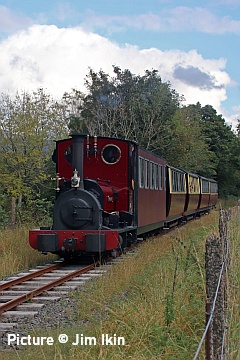
Forthcoming events
(see also our Calendar page for venues)
Note: we have removed all entries relating to meetings as the events are cancelled.
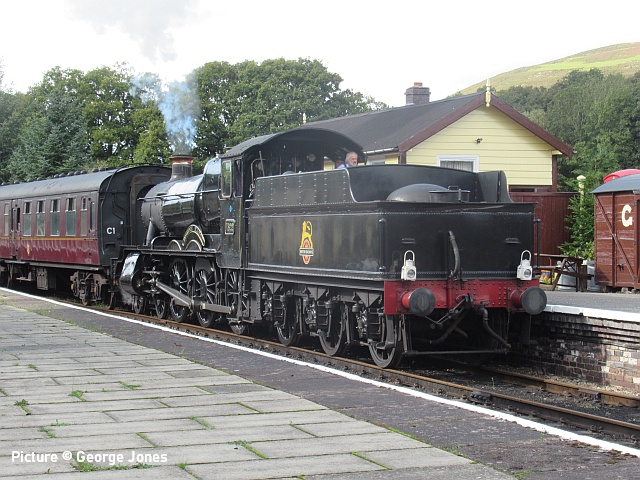
The penultimate Llangollen Railway service of the day was seen passing Glyndyfrwdy on 1 October behind 7822 Foxcote Manor, pictured by George Jones. From the end of that day, the railway suspended operations, initially for 14 days, as visitors and staff from outside Denbighshire are prohibited from accessing the line.
Stay safe and stay with us - pre-2010 contributions always welcome. We'll do an extra issue on 9 October as we have a good selection on hand already and not enough time to edit them all. - Charlie
Lockdown (again)
The Welsh Government has added Denbighshire, Wrexham, Flintshire and Conwy to the list of counties which people are not allowed to enter or leave without a good reason; at the time of writing, Gwynedd and Anglesey - and all of England - remain free of such restriction, and travellers are permitted to pass through the restricted area using the A55 road to reach them. However, there are signs that Gwynedd will soon also be locked-down.
We have contacted Transport for Wales regarding the rail situation, and established that passengers to and from England are allowed to travel direct on trains to reach the Gwynedd stations at Bangor and points west.
They told us via Twitter: ' Trains will continue to run as scheduled with local restrictions in place ... We do ask customers to consider if their journey is necessary. However, trains will be running through restricted areas and customers will not be able to enter/leave a station without a reasonable excuse.' (Probably not including train photography.) This leaves various matters unclear, such as travel within counties, e.g. Llandudno to Colwyn Bay. Readers are invited to investigate.
The Cambrian Coast line is not affected at present as its northern section is in Gwynedd; whether a passenger from unrestricted territory to Blaenau Ffestiniog is allowed to change at Llandudno Junction we haven't asked, but the service on the newly-reopened Conwy Valley line is very restricted in any case.
Loco-hauled news
Chris Parker writes: I managed to get a little more information from a TfW representative at a Chester Shrewsbury Community Rail Partnership virtual meeting which I took part in on 29 September. Assuming that further Covid restrictions don't get in the way, staff training on the loco-hauled Mk4 Coaches is planned to start in October with the sets due to enter service in 'late December'.
[The only Mk4 operated services will be on the Holyhead - Cardiff route, with the third rake being a 'hot spare' and used for cycling trains for maintenance.]
From Dave Sallery's Archive
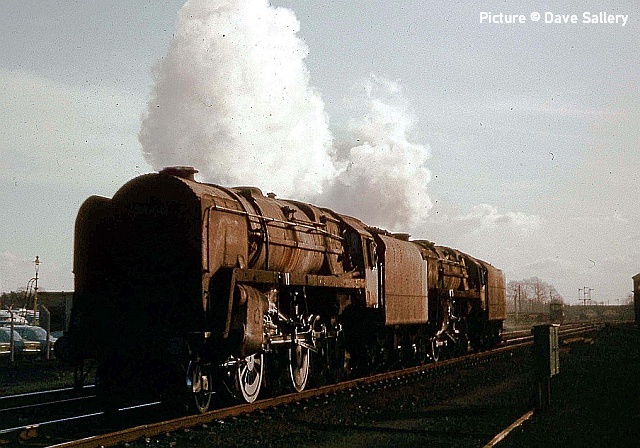
A pair of '9F' 2-10-0s at Hooton, 1960.

Against a background of withdrawn locos at Tinsley, a line-up of 08 509 Wath ETD, 08 141 and 08 876. 21 March 1992.
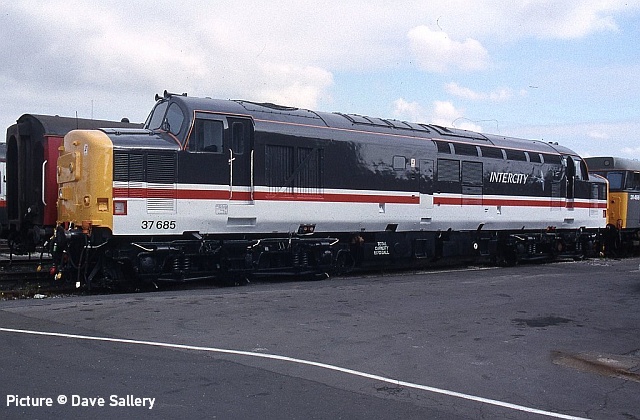
37 685 on 5 September 1993 at Doncaster works, newly repainted for use on London - Scottish Highlands sleeper trains on the non-electrified section north of Edinburgh to Aberdeen and Inverness, an arrangement which lasted from 1992-95 . The 37s worked in pairs, coupled to a generator vehicle as they were not fitted with train hearing circuits. In 1996 37 685 was re-allocated back to the freight fleet and in 1999 it was put into store. For almost a year in 1999-2000 it worked in France on infrastructure work. In 2007 it was sold to West Coast Railways who named it Loch Arkaig, and it remains in their active fleet today.
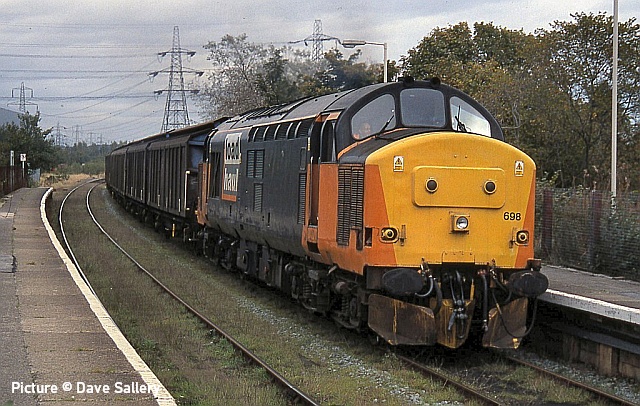
37 698 in Load Haul livery at Hawarden Bridge on 4 November 2001 working a freight trip to Warrington Arpley. The vans carried newsprint from the Shotton Paper Company to Irvine in Scotland.
Looking back: Welshpool and Llanfair, Part 1 - with David Pool
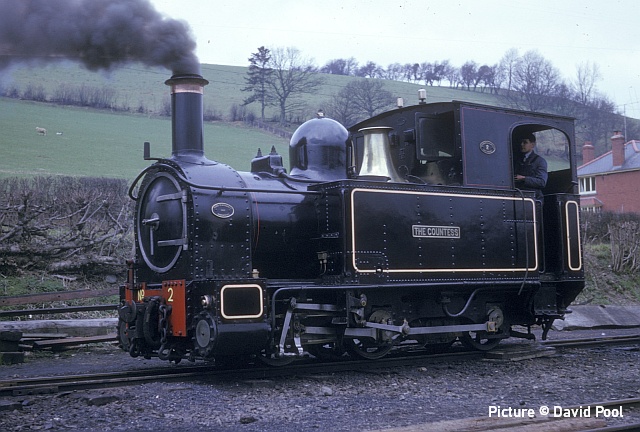
Built by Beyer Peacock in 1902 for the opening of the line, on 2 March 1964 No.2 The Countess was at Llanfair Caereinion preparing to take a train to Castle Caereinion, the terminus at that time. The name and number do not strictly match the condition of the locomotive, which shows the minor modifications carried out by the Great Western Railway, after which it was renumbered 823 with the name Countess.
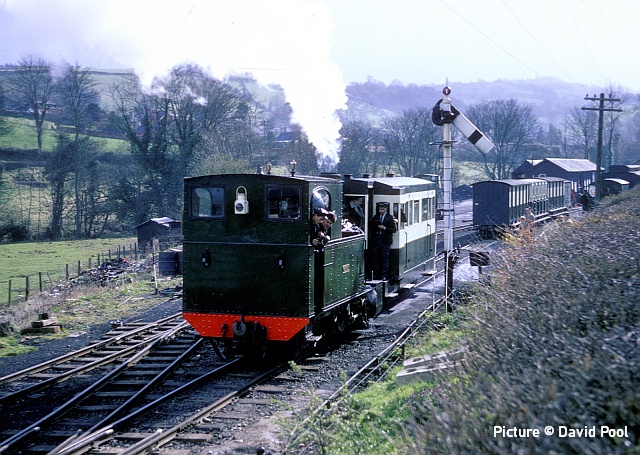
No.1 The Earl is leaving Llanfair with the 16:00 departure to Castle Caereinion on 28 March 1967. Its green livery is more appropriate for the GWR period, but then it would have been No.822. The coach is the Combination Brake Van, built by Wickham in 1957 for the Navy’s Chattenden and Upnor Railway at Lodge Hill in Kent, which had recently closed. Today this coach is on the Welsh Highland Railway, having been regauged and now designated Works Carriage 1001.
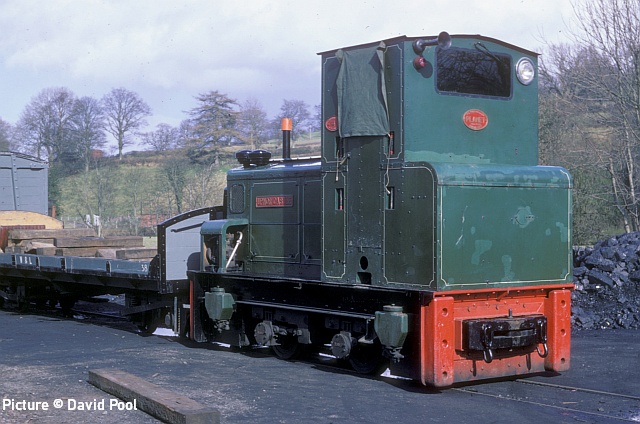
Another purchase from the Chattenden and Upnor Railway was a Planet diesel, built by F.C.Hibberd in 1954. This was Yard No.44, which became No.4 at Welshpool and carried the name Upnor Castle when photographed on 28 March 1967. In 1968 it was sold to the Ffestiniog Railway, where it was re-gauged, and has since had an eventful life, being particularly appreciated during the building of the Welsh Highland Railway. The Welsh Highland Railway Heritage Supplement December 2010 relates the story of this survivor, which has somehow been kept going for many years, in spite of failures and replacement of most of its mechanical components!
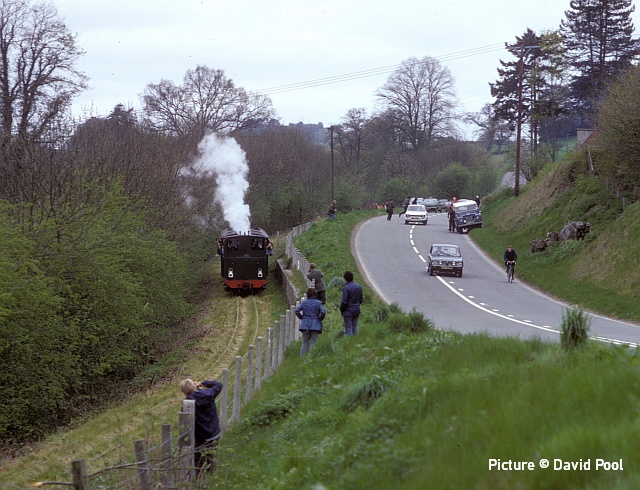
12 May 1973 was the day the reopened W & L reached Welshpool, although only as far as Raven Square and not through the town. The Earl had left Llanfair at 1100 with a Special train, and was descending the Golfa Bank rather cautiously. The steep gradient and overgrown track were negotiated successfully, and this marked the beginning a new and successful era for the railway.
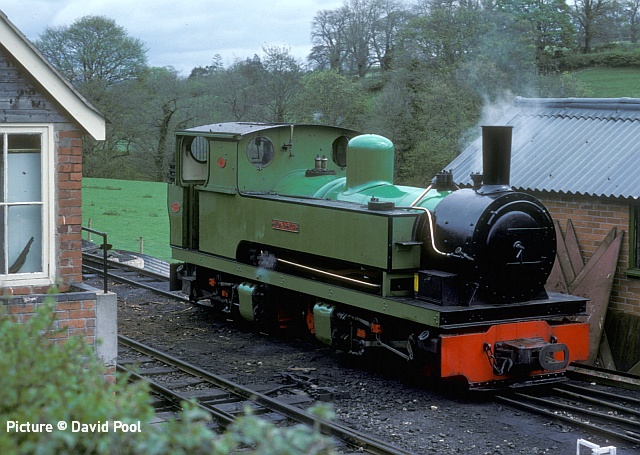
Monarch is a Meyer-type articulated steam locomotive with two power bogies, built by Bagnall in 1953 for Bowater’s Railway in Sittingbourne. In 1966 it came to Llanfair, and was found to require a major overhaul. I was fortunate to be able to photograph it in steam on 13 May 1978 at Llanfair, since it had been found to be less suitable than the other W & L locomotives, and was not used regularly. It was sold to the Ffestiniog Railway in 1992, where it would have required major modifications and regauging, and with other locomotives becoming available for the FR and Welsh Highland Railway it was eventually agreed to return Monarch to the W & L, where it is now displayed at Welshpool, Any return to steam is now most unlikely.
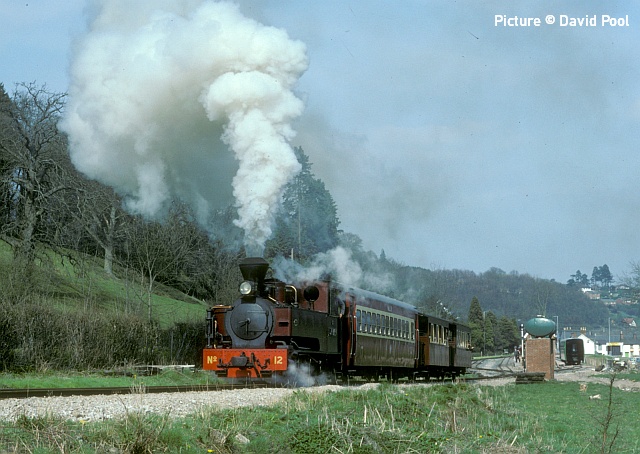
No.12 Joan was built by Kerr Stuart in 1927 for a sugar cane railway in Antigua, West Indies. It was returned to the UK and entered service on the W & L in 1977, where it has been a regular and reliable performer. It was photographed on 17 April 1982 leaving Welshpool and about to tackle Golfa Bank.
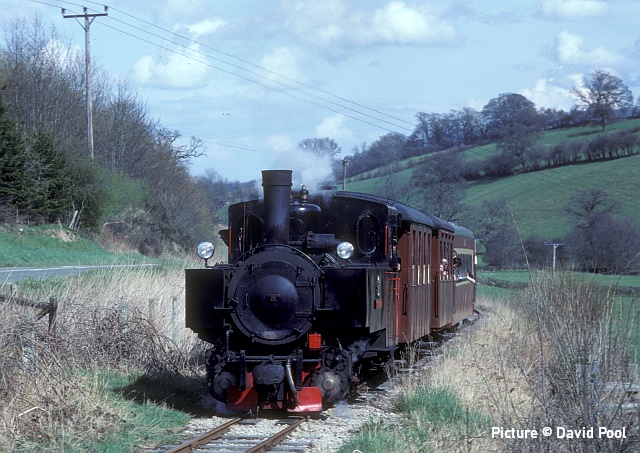
Sir Drefaldwyn (County of Montgomery), photographed near Welshpool on 9 April 1983, was one of the most successful locomotives obtained by the restored W & L. It was built by Societe Franco-Belge in 1944 for the German Military Railways, and in 1946 went to an Austrian railway near Salzburg. In 1955 it moved again to another railway in Austria, where it was rebuilt from an engine with a tender to a purely tank engine, working there until 1965. A few years later the W & L acquired some Austrian coaches, which proved very satisfactory, and contacts led to the purchase of locomotive 699.01 in 1969. It entered service in 1970, and as Sir Drefaldwyn operated until its boiler 'ticket' expired in 2000. A major overhaul started in 2014, and it is hoped it can be returned to service before too long.
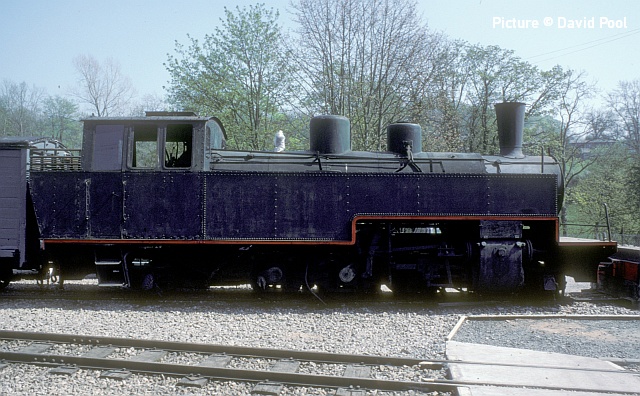
No.5 is another locomotive which was not really suited to the W & L. It was built by Tubize in Nivelles (Belgium) in 1948 for the Jokioinen Railway in Finland. It operated there until 1964, when it was stored out of use. In 1972 it was exported to England, and eventually reached the W & L in 1983. My photograph was taken at Llanfair on 5 May 1984. After a major overhaul it went into service in 2000 as No.5 Orion, but was found to be too big and too heavy for the line, and was not often used. The Jokioinen Railway, now a working Museum, was keen to take back No.5, and it returned to Finland in 2008.
Steam snapshots
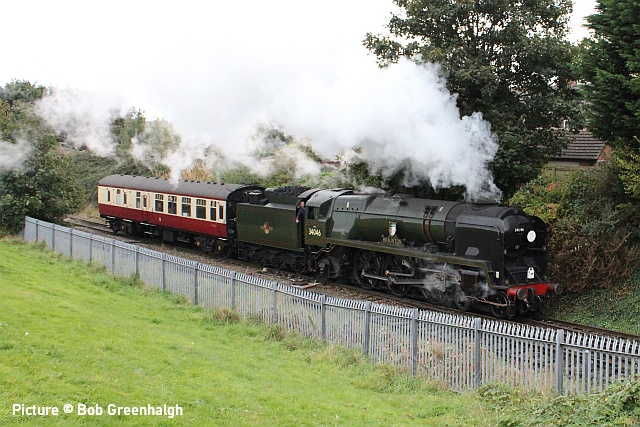
34046 Braunton approaches Chester on test, 30 September (Bob Greenhalgh).
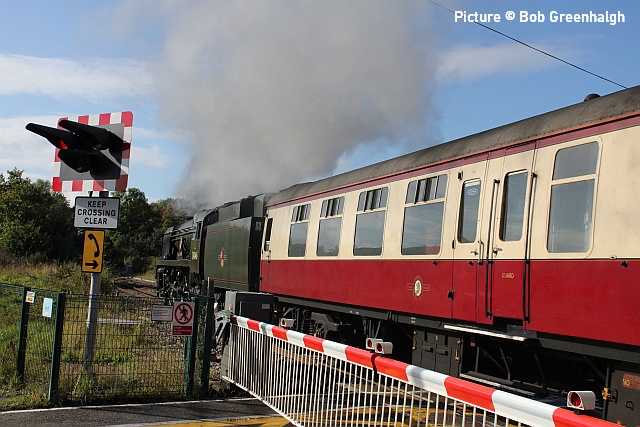
34046 again, this time going away at Balderton crossing on 1 October on a Locomotive Services Limited circular run Crewe - Chester - Shrewsbury - Bushbury Junction - Stafford - Crewe luckily in super sun and blue skies. Braunton looked and sounded superb (Bob Greenhalgh).
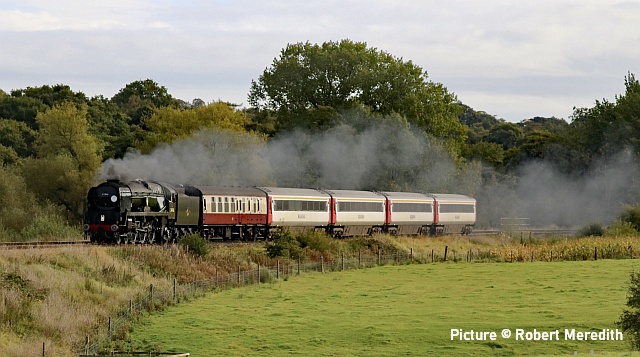
Behind 34046 were a support coach and four Rail Charter Services (ex-Greater Anglia) Mk 3 coaching stock, which had recently been used on the Settle & Carlisle ‘Staycation Express’ Skipton to Appleby services, seen passing Beeston Castle (Robert Meredith).
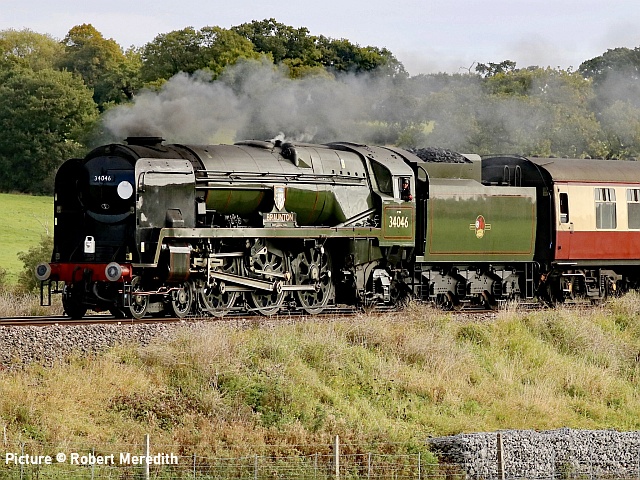
A closer view, by Robert Meredith.
RHTT doings
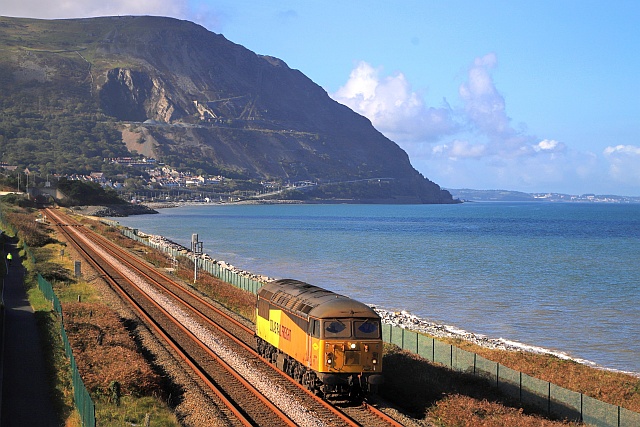
56 096 at Dwygyfylchi running about 45 minutes late ...
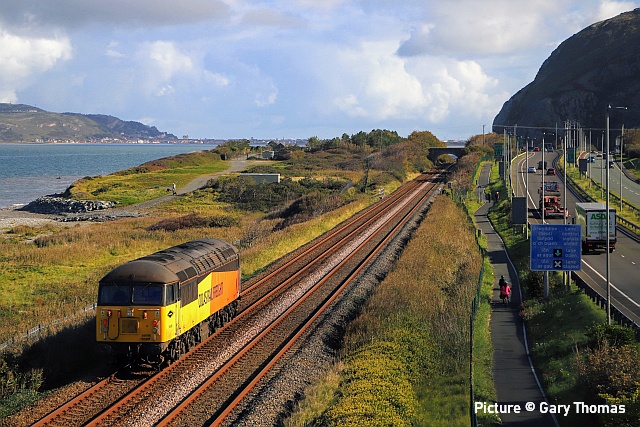
... with a return light engine movement from Holyhead to Chester on 29 September (Gary Thomas).
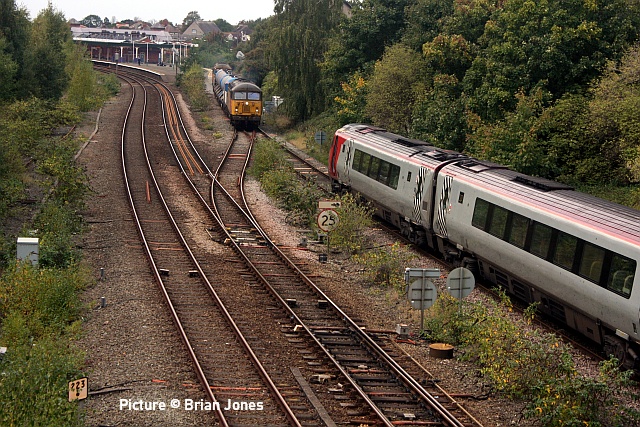
Brian Jones writes: 'I went to Queens Road bridge at Llandudno Junction on 2 October to photograph the return Rail Head Treatment Train. Lo and behold, when I got there a Voyager had stopped straddling the bridge.' It was held there due to a 'signalling failure'; this unit was working the 10:52 Crewe - Holyhead, terminated at Llandudno Junction at 12:02 and held there until 14:43 when it took up its booked schedule to Crewe.
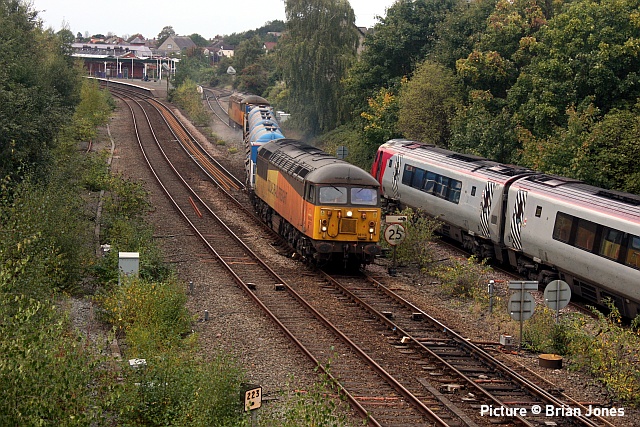
The RHTT (56 113 leading) came through platform 1 and had to do a bit of 'right hand down a bit' to take the crossover and go round it ...
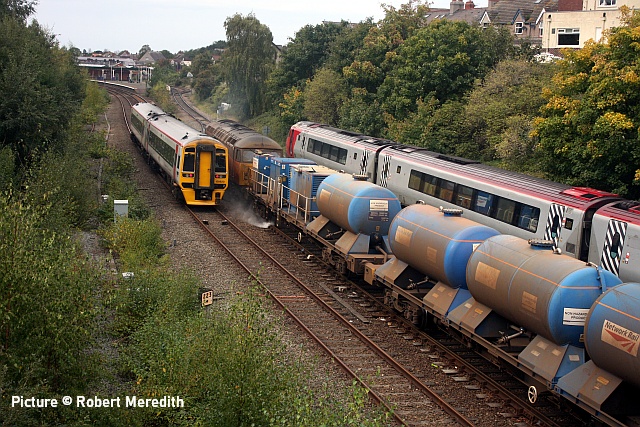
... just as 158 820 arrived with the 12:58 Chester - Llandudno which had started from Rhyl and was itself terminating.
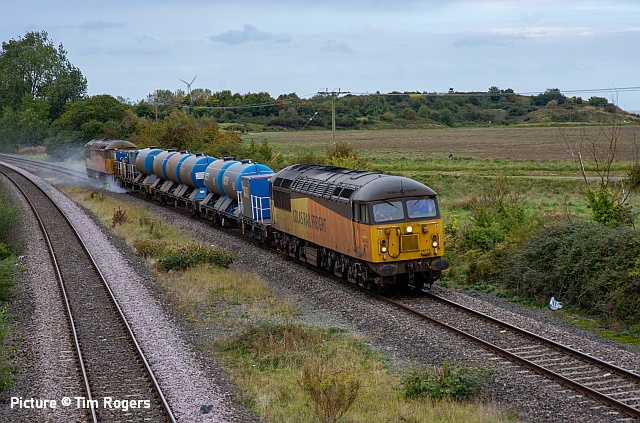
Bagillt, 2 October (Tim Rogers).
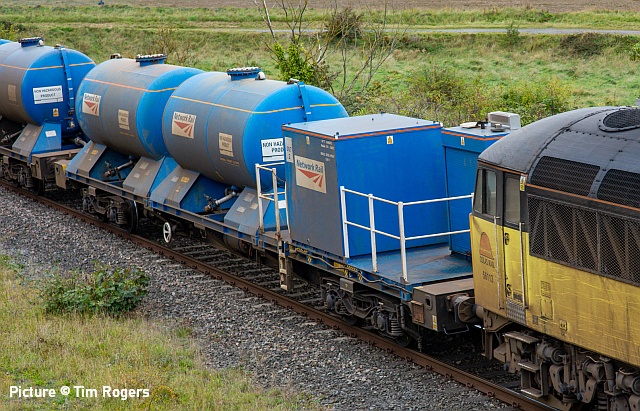
A detail of FEA wagon 642027 (Tim Rogers).
Out and About - with Jim Ikin
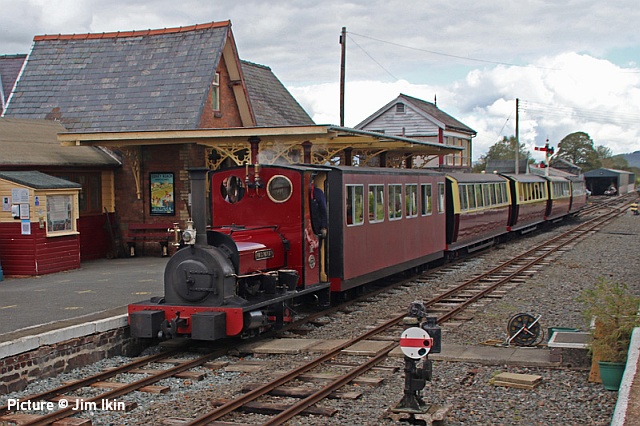
On Tuesday 29 September we went on what turned out to be a pre-local-lockdown runabout to the Bala Lake Railway where Maid Marian was on duty.
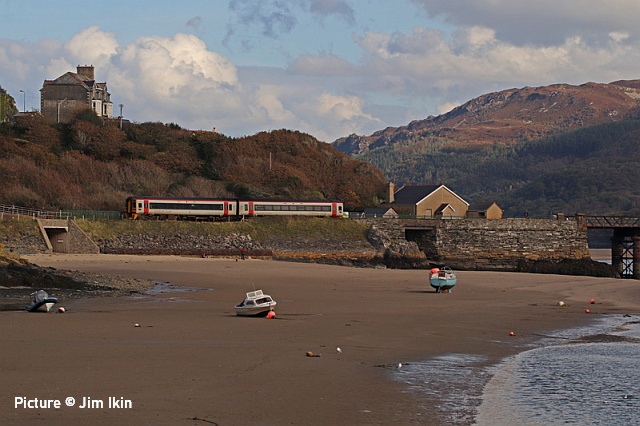
Carrying on to Barmouth in real shirt-sleeve weather. Abive, 158 834 approaches ...
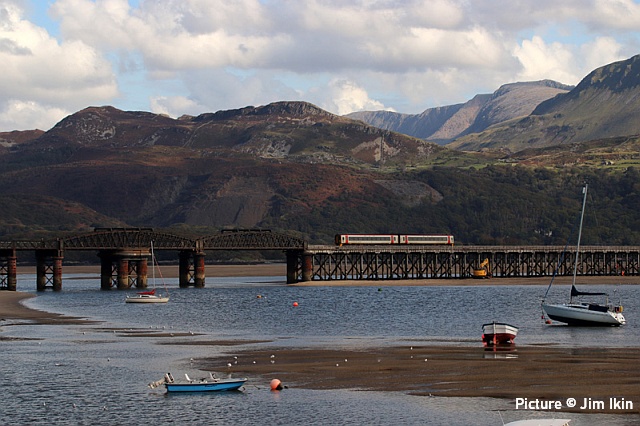
... and carries on over the bridge where work being carried out on the £25 million upgrade of the Grade two listed bridge was underway: diggers and scaffolders working below.
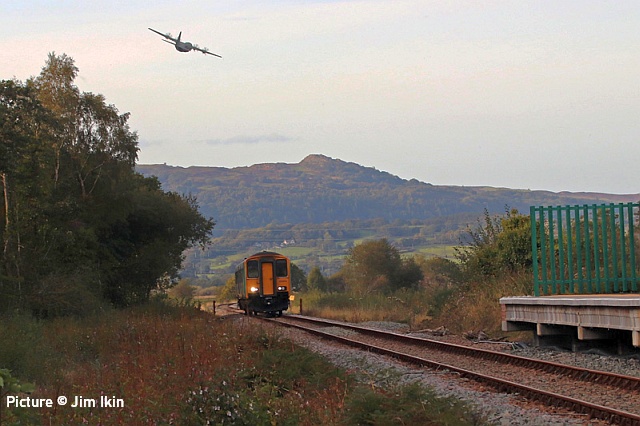
Further to the Conwy Valley line reopening on the Monday, a coincidental crossing of transportation in the form of a C130 aircraft and 150 254 on the approach to the newly-rebuilt Dolgarrog station.
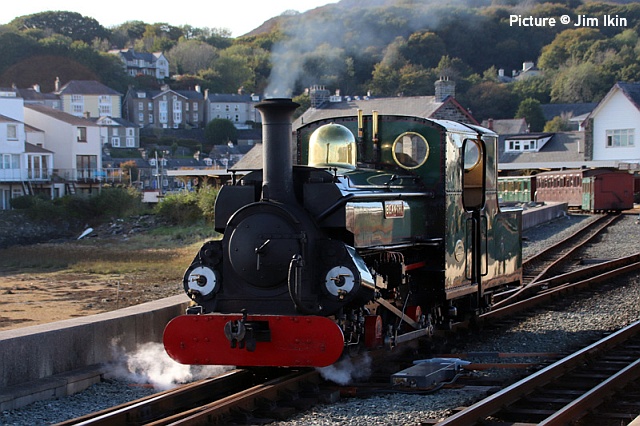
Blanche at Porthmadog before we were required to come home to Conwy County – although you can still get to the Ffestiniog in Gwynedd down the A55 corridor via Caernarfon.
Walking the Cambrian, 2: Penrhyndeudraeth to Llandanwg -with Eryl Crump
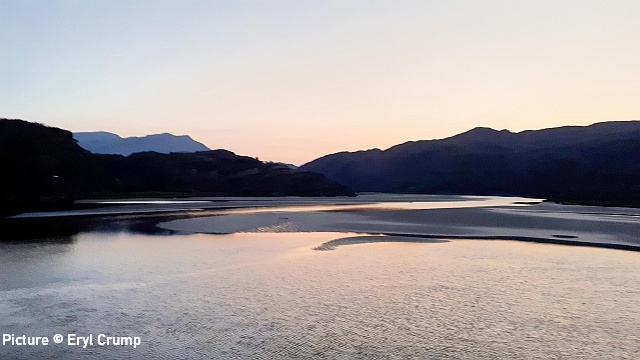
It was an early start from Penrhyndeudraeth to avoid the high tide on the section from Llandecwyn (above) to Ynys after crossing Pont Briwet across the Dwyryd.
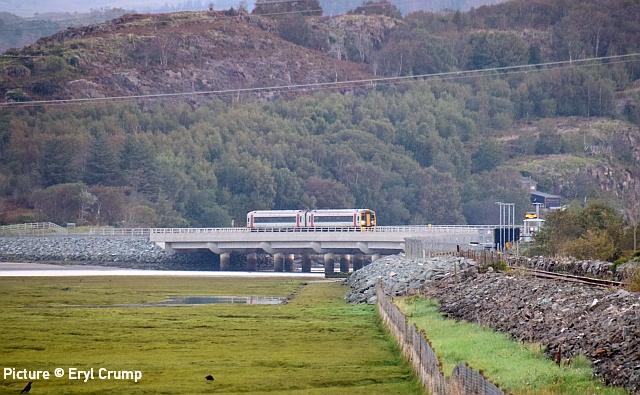
Crossing the Cambrian Coast line at a foot crossing I waited from the 06:29 Pwllheli to Machynlleth to pass, worked by 158 837.
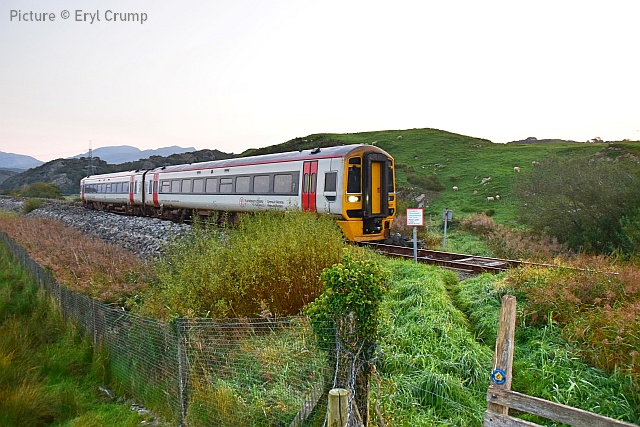
It was still a bit squelchy but much easier on the track rather than the slate wall itself.
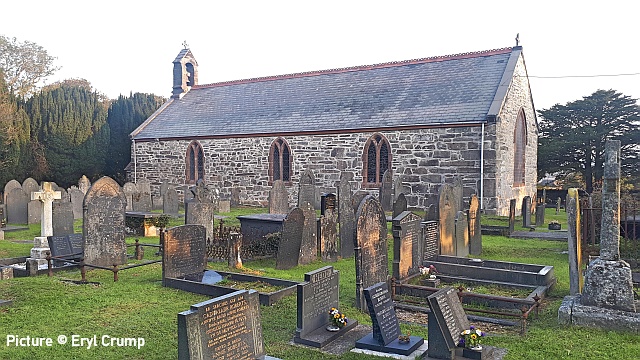
Its a 3.5mile section to St Michael's church at Llanfihangel-y-Traethau near Talsarnau. Ty Gwyn station is closest. The name Llanfihangel-y-Traethau translates as 'St Michael's on the Beaches', for at the time it was founded, the church would have stood on a rocky islet, surrounded by marshes. It was not until the late Middle Ages that the tide receded, leaving Ynys church well inland.
The church is a Grade II listed building and dates to the thirteenth to fifteenth century. he building is thought to have been restored in 1845, when new windows were inserted and the roof replaced. It was restored again in 1866, when the west gallery was removed and further work carried out in 1884, when underfloor ventilation was introduced. The existing windows were inserted at this time. During restoration the fragments of two inscribed stones were found.
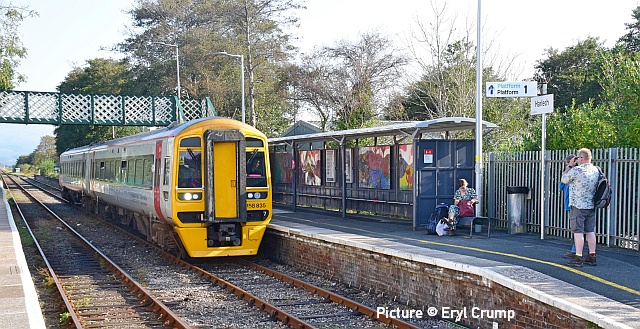
An easy walks for the next three and a half miles follows the coast and then through some woodland and across fields to Harlech. At the station the 09:34 Pwllheli to Machynlleth (158 835) was on time but the 08:54 from Machynlleth was about 45 minutes late. I didn't wait and pressed on. I later saw (and photographed) the service at Llandanwg.
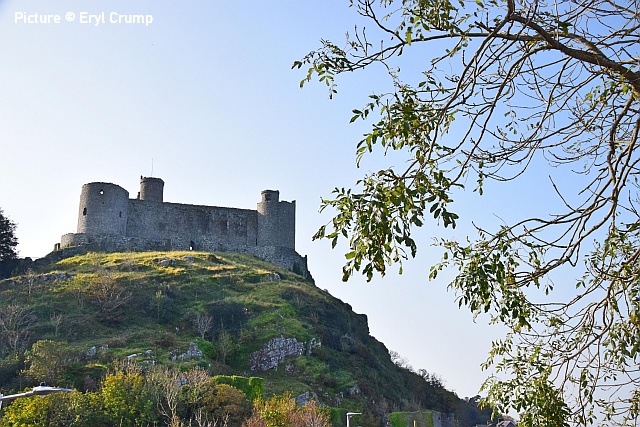
The castle looms over Harlech.
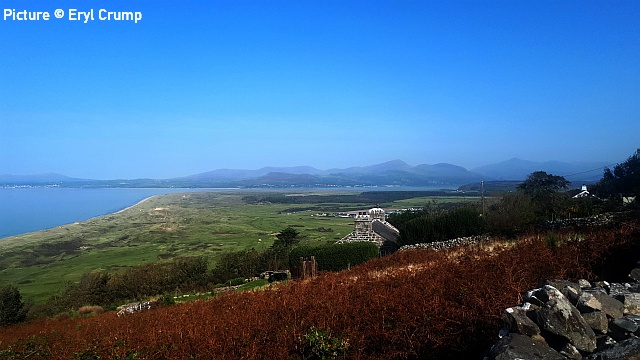
The three-mile section from Harlech to Llandanwg is initally seriously uphill up Ffordd Pen Llech, 'the world's steepest road' to the town centre and is followed by a steep-ish climb on the Old Llanfair Road to Llandanwg. What goes up must come down and its a nice downhill section to the beach which shelters St Tanwg's Church although sand is regularly cleared away from its surrounds.
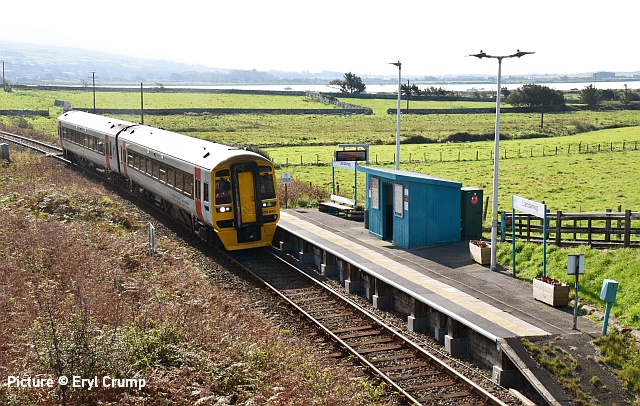
Llandanwg station, with 158 840. [Along with other short-platform halts, this station is currently closed to passengers due to social-distancing issues.]
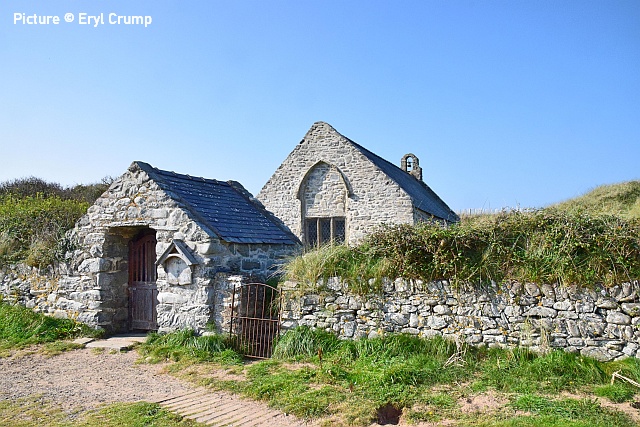
The current Church building is medieval, with the western end possibly dating back to the 13th century. However, the presence of 6th century inscribed stones, and the dedication to St Tanwg, suggest much earlier use of the site as a church, possibly dating to around 453 AD as part of Saint Patrick's work to establish links between Ireland and Britain.
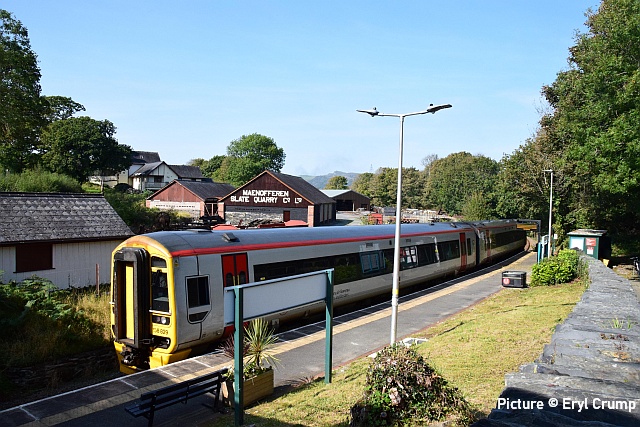
The walk to Pensarn is along the estuary of the Artro river. The train was possible but I caught the bus as it saved me 15 minutes, plus I could use my concessionary pass. At Minffordd 153 829 was on time as I waited for the two Ffestiniog Railway lunchtime trains to cross (Linda heading to Tan-y-bwlch and Blanche heading back to Porthmadog Harbour).
North Wales Coast home page | Archive | Previous Notice Board